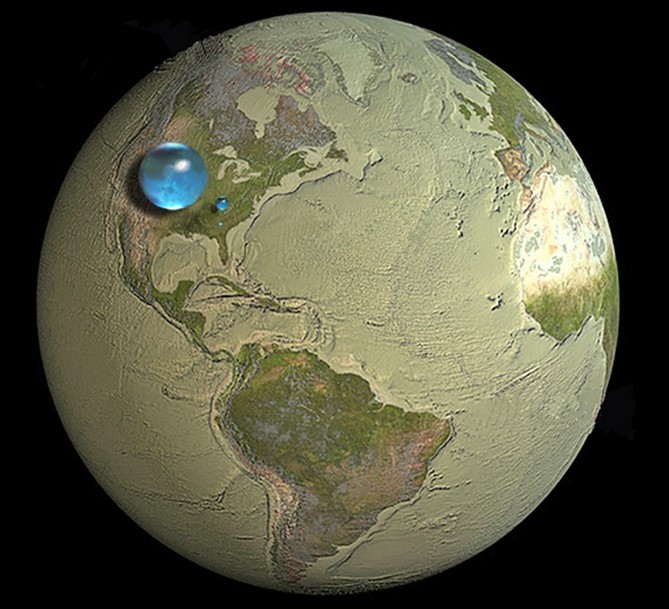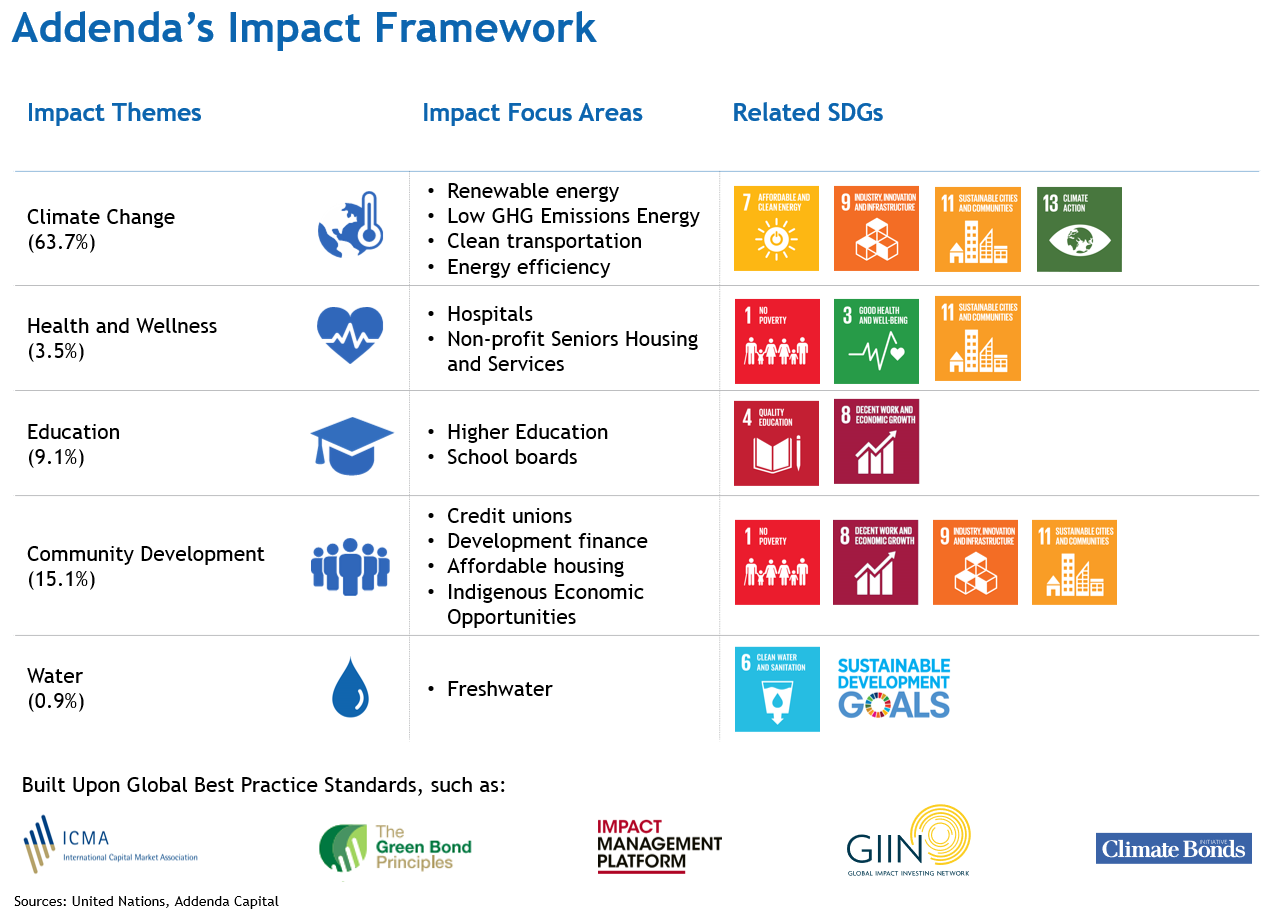Published on: April 3, 2024

Vice President, Sustainable Investing

Vice President, Fixed Income and Head, Corporate Bonds
Without water there is no life. A finite amount is available as fresh water to humans and nature - only 2.5% of all global water – yet, too often we treat it as infinite (1). The rest is in the oceans, locked in ice sheets, or deep groundwater aquifers.

Figure 1 A representation of the world’s fresh water availability. Only 2.5% of all global fresh water is readily available with the remaining being oceans, locked in ice caps, glaciers or very deep groundwater aquifers. The larger sphere represents the portion available both at the surface and accessible groundwater and the smaller the proportion at the surface only (rivers and lakes). Source: How Much Water is There on Earth? | U.S. Geological Survey (usgs.gov)
While societies and economies depend on access to freshwater systems to thrive, an estimated one quarter of the global population faces extremely high water stress (2). From Alberta and Australia to Southern Africa and the US Southwest - and many places in between - the availability of fresh water to grow food, support local economies and communities is starting to hit hard limits (3). Compounding these issues is that there will only be increasing competition over limited freshwater resources as populations grow and as climate change drives increasing variability in how we get water. We are now experiencing longer droughts, and when we get water, it’s more often coming in storms that create severe floods (4).
Access to clean water and sanitation is a human right (5). Despite progress, over 2 billion people still lack access to safe, managed drinking water and basic sanitation (6). Vulnerable communities are often disproportionately affected. In developing countries, women and girls are most likely to be responsible for fetching water for households, spending sometimes hours each day, leading to inequities in access to education and a better life (7). Water safety issues plague developed countries as well. Flint, Michigan, is the poster child of poor oversight and lack of investment in water systems where lead pipes, leached into municipal drinking water, impacting disproportionately a minority community struggling with poverty (8). In Canada alone there still remain 28 long-term drinking water advisories within Indigenous communities – which often have deep cultural connections to water resources (9).
In addition, the quality of water has in many regions been degrading through urbanization, channelization, over-extraction and pollution caused by chemicals, fertilizers and microplastics. Globally, an estimated half of wastewater is released into the environment untreated (10). The waste now entering water bodies can also include chemicals of concern that potentially have long-term environmental or health impacts. A snapshot of the scale of this problem, provided by a recent study out of California, highlighted that of 172 consumer product categories, 105 contained chemicals that were carcinogens or toxins with known reproductive or developmental impacts (11).
Protecting and preserving water quality globally is becoming critically important given we are crossing a key planetary boundary in this area (12). The water molecule is a sticky one, and pollutants cling tightly. Therefore, separating contaminants bonded to H2O requires significant amounts of energy and technical know-how. This means that it is almost impossible to reverse at the scale we are polluting freshwater resources globally. Desalination, while appropriate for some regions, is not feasible at a global scale due to the very large energy demands, carbon emissions and waste streams produced.
Nowhere are biodiversity losses more acute than in freshwater ecosystems, with an average biodiversity loss rate double that of land and ocean species (13). Rivers, lakes, and wetlands often serve as the breeding and nursery grounds of many species - insect, reptile, bird, and fish - that have evolved to live in very specific water quality or temperature ranges, making them very vulnerable to changes in these systems.
Water systems and infrastructure also tend to get overlooked when it comes to investing in new or maintaining existing systems, with politicians often favouring above-ground infrastructure projects versus those hidden below ground. Across North America, water delivery pipes are estimated to leak up to 40% of treated water. The City of Toronto alone wastes 103 million litres per day, which is the equivalent of over 40 Olympic-sized swimming pools (14). Drinking water infrastructure received a score of “C-” in the latest American Society of Civil Engineers’ (ASCE) report card, and it’s estimated that the investment gap in water infrastructure in the US alone will grow to US$400 billion over the next five years (15).
Although the challenges seem large, there is much investors can do to mitigate impacts on water resources or to invest in solutions (16). The Valuing Water Principles provide high-level guidance on how to conceptualize the value of water, be it from the bathtub to the boardroom - with the principles of protecting the sources and embracing water’s multiple values perhaps being the most foundational (17). The Valuing Water Finance Initiative, a project looking to activate the above principles, is a network and platform that benchmarks high water-dependent companies on their water practices while bringing together shareholders to engage company leadership on improving practices and protecting freshwater systems (18). Addenda is supporting this initiative through our stewardship efforts.
Addenda is pleased to launch “Water” as a new theme under our Impact Fixed Income Strategy, with a primary focus on fresh water (with ocean and marine criteria planned for the future) The addition of water builds upon and fortifies our existing core themes of climate, community development, education, and health and wellness.

Investment Opportunities
Our focus area will seek investments targeting projects that improve access to drinking water and sanitation, invest in water efficiency technologies such as leak prevention, drip irrigation and smart water metering, in nature-based solutions such as wetland and watershed restoration and support the improved delivery and treatment of water, waste and stormwater in communities, among many other areas.
Our approach will be guided by the Valuing Water Principles, which recognize water’s multiple values including cultural and Indigenous values, as well as water for nature. We will also be guided by Do No Significant Harm Principles (19).
Although the market for “blue” or water-oriented and waste management bonds is small compared to green and climate-oriented bonds, hovering around the 10 percent mark, we anticipate that needed investment in water will only grow . We also see the possibility of more climate bonds having greater water management components given that climate and water issues are completely interlinked (21). An example of recent investments is the City of Vancouver Green Bond, which has a significant amount of use of proceeds designated for sustainable water and wastewater management. This includes replacement of sewer infrastructure to critically separate stormwater pipes from sanitary waste pipes, therefore reducing flood risks and better protecting local water bodies from polluting sewage and stormwater overflow events (22). The Government of Canada Green Bond raised money for improvements in water supply and wastewater management in Indigenous communities, plastics reduction programs, along with terrestrial and aquatic biodiversity conservation programs, and many other energy and climate projects (23).
We see the evidence of investment gaps in water infrastructure and resources. To ensure the market thrives, we welcome water projects being part of climate and adaptation bonds, and even separate blue-focused water bonds, as long as issuances are of sufficient size and scale to meet liquidity needs of investors.
For the moment, investment opportunities in the Canadian market are few and far between. For example, we have yet to see any bonds that can be classified strictly as water-related, such as blue bonds. Even at an international level, the blue bond market is still very small, representing only about $US 13B of issuances (based on our calculations).
However, there are some sustainability bonds in Canada that have allocated use of proceeds to water-related investments. These were issued by government entities. We believe that these opportunities in our new theme will continue to occur mainly through general sustainable bond frameworks rather than blue bonds. There are already other government entities and companies whose green or sustainable frameworks include eligibility for water projects. According to our criteria, there are close to $CAD 10B in outstanding bonds provided by four issuers in the Canadian market that allocate some of their funds to water-related investments. Financing opportunities tied to water projects, we believe, are still in their infancy in Canada. Addenda Capital’s Sustainable Investing team and Fixed-income investment team look forward to the development of this new theme in Canada, participating in its growth, and eventually witnessing the arrival of blue bonds that satisfy our criteria.
We are excited to be taking these steps on our journey of investing more in water infrastructure and water resources.
Related Contents
Impact Fixed Income
Sustainable and Impact Solutions
To Deepen Your Knowledge
1. How Much Water is There on Earth? | U.S. Geological Survey (usgs.gov)
2. World Resources Institute (WRI): 25 Countries, Housing One-quarter of the Population, Face Extremely High Water Stress
3. CBC; The Economist; NPR
4. How Climate Change Impacts Water Access (National Geographic)
5. United Nations: The Human Right to Water and Sanitation
6. United Nations Sustainable Development
7. WHO: Women and girls bear brunt of water and sanitation crisis
8. CDC: Flint Water Crisis
9. Government of Canada: Ending long-term drinking water advisories
10. United Nations University: Half of global wastewater treated
11. Know, Kristin et al, Identifying Toxic Consumer Products: A Novel Data Set Reveals Air Emissions of Potent Carcinogens, Reproductive Toxicants, and Developmental Toxicants, Environmental Science and Technology 2023, 57, 7454-7465
12. See biochemical flows (Phosphorus and Nitrogen) and freshwater changes in 2023
13. Bending the Curve of Global Freshwater Biodiversity Loss: An Emergency Recovery Plan
14. Water Canada: Significant amount of drinking water being wasted due to leaky pipes: Report
15. 2021 Report Card for America’s Infrastructure
16. CDP Water, Ceres, WRI, Recommended Best Practices in Disclosure for Water and Sewer Bonds
17. Valuing Water Initiative
18. Ceres: Valuing Water Finance Initiative
19. See Table 4 with Do No Significant Harm Criteria
20. See Use of proceeds graph and dataset in the dashboard: Market Data | Climate Bonds Initiative
21. Climate Bonds Initiative: Use of Proceeds Charts
22. City of Vancouver Annual Green Bond Information Update 2021
23. Government of Canada - Green Bond Framework - Canada.ca